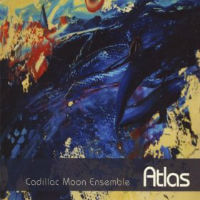 With the plethora of new music ensembles out there and the various instrumentations they employ, it’s nice to stumble upon one where the geometry works, the ensemble functions well as a collective unit, and the compositions performed are a good fit rather than an endless list of premieres. All the better when such an ensemble is young and presents themselves without a hint of pretention. Cadillac Moon Ensemble’s debut full CD, Atlas, presents these rare qualities in the combination of flute, violin, cello, and percussion.
With the plethora of new music ensembles out there and the various instrumentations they employ, it’s nice to stumble upon one where the geometry works, the ensemble functions well as a collective unit, and the compositions performed are a good fit rather than an endless list of premieres. All the better when such an ensemble is young and presents themselves without a hint of pretention. Cadillac Moon Ensemble’s debut full CD, Atlas, presents these rare qualities in the combination of flute, violin, cello, and percussion.

First, New Dynamic Records has done an excellent job at producing a very well-recorded, well-packaged album. While chamber music recordings often lack the presence of a live performance, on this CD the instruments sound almost as though they’re in the room with you, and the different tone shadings come through with clarity. The ensemble balance is captured quite well—a difficult feat considering the instrumentation. Whatever they’re doing at Indiana University Southeast’s recording studio to make this happen, I look forward to more of it. Designer Amie Villiger has packaged the CD with an enticing cover, an inviting feel, an artistic quality without becoming to “artsy,” and a clarity to the information. I very much appreciate the attention given to promoting the composers of the music; this is, after all, one of the most important points of a new music ensemble.
 The individual composers featured on Atlas bring unique musical ideas in a way that highlights the ensemble’s strengths without ever going to excess in their use of instrumentation. This is particularly impressive with the percussion: while many different timbres and instruments come forward, it is never over-powering and still sticks to a relatively minimal rig. Each composition has its own elements that make it tick, and as such my interest was maintained for the whole CD (something I can’t usually say). If there is one all-around compositional weakness, it’s one that reflects the relatively young age of the composers: their pieces come close to but don’t quite reach that feel of a coherent well-structured whole (though they are by no means random or lacking solid, cohesive ideas or development). But in this case, I’ll gladly accept this small shortcoming to hear some fresh ideas from up-and-coming composers, and I commend Cadillac Moon Ensemble for their selection of music and conscious attention to promoting these composers.
The individual composers featured on Atlas bring unique musical ideas in a way that highlights the ensemble’s strengths without ever going to excess in their use of instrumentation. This is particularly impressive with the percussion: while many different timbres and instruments come forward, it is never over-powering and still sticks to a relatively minimal rig. Each composition has its own elements that make it tick, and as such my interest was maintained for the whole CD (something I can’t usually say). If there is one all-around compositional weakness, it’s one that reflects the relatively young age of the composers: their pieces come close to but don’t quite reach that feel of a coherent well-structured whole (though they are by no means random or lacking solid, cohesive ideas or development). But in this case, I’ll gladly accept this small shortcoming to hear some fresh ideas from up-and-coming composers, and I commend Cadillac Moon Ensemble for their selection of music and conscious attention to promoting these composers.
André Brégégèré’s En Route does well at highlighting each instrument in strong melodic motives and sustained, dissonant melodic lines. The solid tones of Roberta Michel’s flute and Michael Midlarsky’s cello are particularly bold and resonant on this track. These solo moments give way to ensemble dialogue, and the alternation between more “free” solo moments with ensemble passages of well-defined rhythmic repetition gives a nice variety. I found the moments of steady pulse in the percussion combined with pizzicato in the strings particularly effective.
Angélica Negrón’s two pieces draw on Puerto Rican musical elements but put them in a decidedly contemporary classical context. I was most impressed with the lengthy angular lines of the flute in interaction with the full ensemble’s background. The near grooves the music at times reached, including with words chanted by the ensemble, were quite infectious. The interplay between melodic and (at times almost insistent) rhythmic motives created a sense of development and dialogue.
Shawn Allison’s Towards the Flame did well at evoking his extra-musical influence of moths. The scuttling flute that interrupted itself with brash tones was particularly effective at this in the first movement. The second movement made excellent use of the cello and flute’s register and did well at taking its time to present the material, building up to a more epic, dramatic, full-ensemble moment. The best moment for me was when Patti Kilroy’s violin reached into its upper register with a delicate touch, and the blend of this serene tone with Sean Statser’s beautiful timbres on mallets was exquisite.
Erich Stem’s Revisited evoked the Japanese shakuhachi flute and drew out an array of tones, timbres and effects from both the flute and the ensemble. This piece captured the possibilities of the instrumental combinations in Cadillac Moon exceptionally well. The mallets blending with the flute, drum with a plucked cello bassline, and flute and violin on a melody together were particular highlights in this regard. These duo moments, full ensemble passages, and solo moments in the cello and flute adeptly highlighted the ensemble geometry.
Edward RosenBerg III (who gets the award for best photo in the CD booklet) gives this album its compelling closer with the epic-sounding Galactic Mathematics. Its strong rhythmic enunciation and accent patterns worked well both in background figures and in melodies. The more groove-oriented sections made good use of vocal parts, and the repeated use of a sigh gesture motive made for quite a memorable and in-your-face effect.
Atlas is a well-packaged, well-performed, and well-recorded presentation of several up-and-coming composers. Ensemble Moon Ensemble plays with the right sense of style for the compositions and attention to coherent musical gestures that bring the pieces to life. A stand-out for me (as a woodwind player) was the lush, full tones in the low register of Roberta Michel’s flute—even among the best professionals, not many flute players sound so compelling in a lower register. I look forward to more well-executed, wise musical selections from Cadillac Moon Ensemble and to more excellent releases from New Dynamic Records.
Cadillac Moon Ensemble. Atlas (New Dynamic Records, September 2012) | Buy on Amazon
–-
David Pearson is a saxophonist residing in NYC and a doctoral student in musicology at CUNY Graduate Center.
























